Tired of boring business books? Here are 3 that break the mold.

I'm always intrigued by books with lots of diagrams and images, because they help me engage my right brain – my creative side – when I need to be creative or when I lack motivation to keep reading text that's important yet incredibly boring!
These three books are definitely not boring, and their visuals certainly kept me engaged. In some ways, the visuals are the "stars" in these books because of how well and how creatively they communicate the authors' message. While I can only present a small number of these "stars" here, please rest assured each book contains many more visuals like the examples I've selected.
The Right-Brain Business Plan: A Creative Visual Map for Success, by Jennifer Lee (2011)
Injecting Some Fun into Business Planning!
While the author targets this book to "creatives" – people who create drawings, text, paintings, sculptures, music, and experiences for a living – she also does a great job demystifying the often daunting task of creating a business plan for us left brain folks, too.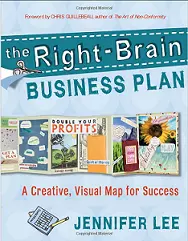
Part of the demystifying has to do with renaming the different parts of a business plan and presenting key tips for each part. (pages 16-20)
- Hearty Highlights is the Executive Summary
- Business Vision + Values is the Company Overview
- Business Landscape is the Competitive Analysis
- Getting the Word Out! is the Marketing Plan
- Managing the Moola is the Financial Plan
- Corralling Your Creative Cohorts is the Management and Personnel Plan
- Making Your Plan Real: Where the Rubber Meets the Road is the Action Plan
- Smooth Sailing System is the Operational Plan
An excellent example of a tip to create "Your Passion and Purpose Proclamation" (traditionally called a "Mission Statement") is to complete the following two sentences (page 46):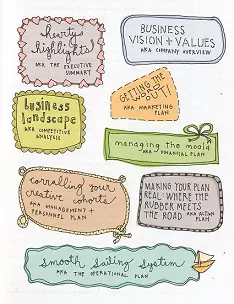
- I am passionate about ____________.
- My purpose is to ____________.
One section I particularly enjoyed was "Engage in a Meaningful Dialogue" in Chapter 4, "Getting the Word Out with Marketing," where she accurately critiqued the traditional "elevator speech." (all quotes from page 86)
- "The problem with a traditional elevator speech is that, by its very description, it's so one-way. With a speech or pitch, you're just talking at someone."
- "When you use a right-brain approach that honors relationship, emotion, connection, and intuition, you move from a canned monologue to a meaningful dialogue with your perfect customer...The interaction is two-way. You ask questions that show you are curious about what their needs are...Use the right-brain first to create an emotional connection and then provide left-brain evidence to support your message."
Bottom Line – The author presents a fresh take on a dry topic, and the book's illustrations effectively reinforce her message!
Imagination Machine: How to Spark New Ideas and Create Your Company's Future, by Martin and Reeves and Jack Fuller (2021)
Outlining a Process to Harness Imagination to Drive Growth
Both authors work at the Boston Consulting Group (BCG), a company based on routinely imagining solutions for its clients. Thus, they treat the process of nurturing imagination and implementing actionable ideas as critically important to any company.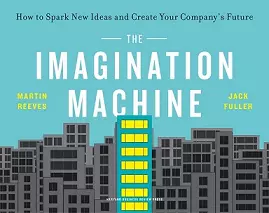
In the book's introduction, the authors liken the current state of companies using imagination effectively to the early days of oil – "... people would just dig around and occasionally strike oil. That's where we are at with imagination today." (page 4) Here is their definition of "imagination":
We define imagination as "the ability to create a mental model of something that doesn't exist yet." This is also know as "counterfactual thinking": the ability to create mental objects that are not merely representations of the outside world. (page 7)
The authors distinguish several related concepts, based on how correlated they are to the real world (page 10):
- Perception – This reflects reality and thus is highly correlated.
- Dreaming – This is unconstrained by the real world and thus uncorrelated
- Imagining – This envisions possibilities and, while grounded in the real world, is loosely correlated to reality
Imagination begins with a surprise, some experience that wakes up the brain so it can begin to rethink, refocus, and direct us to move and probe the world to develop the surprise into an idea, and ultimately communicate the idea to others. Visually, this is:
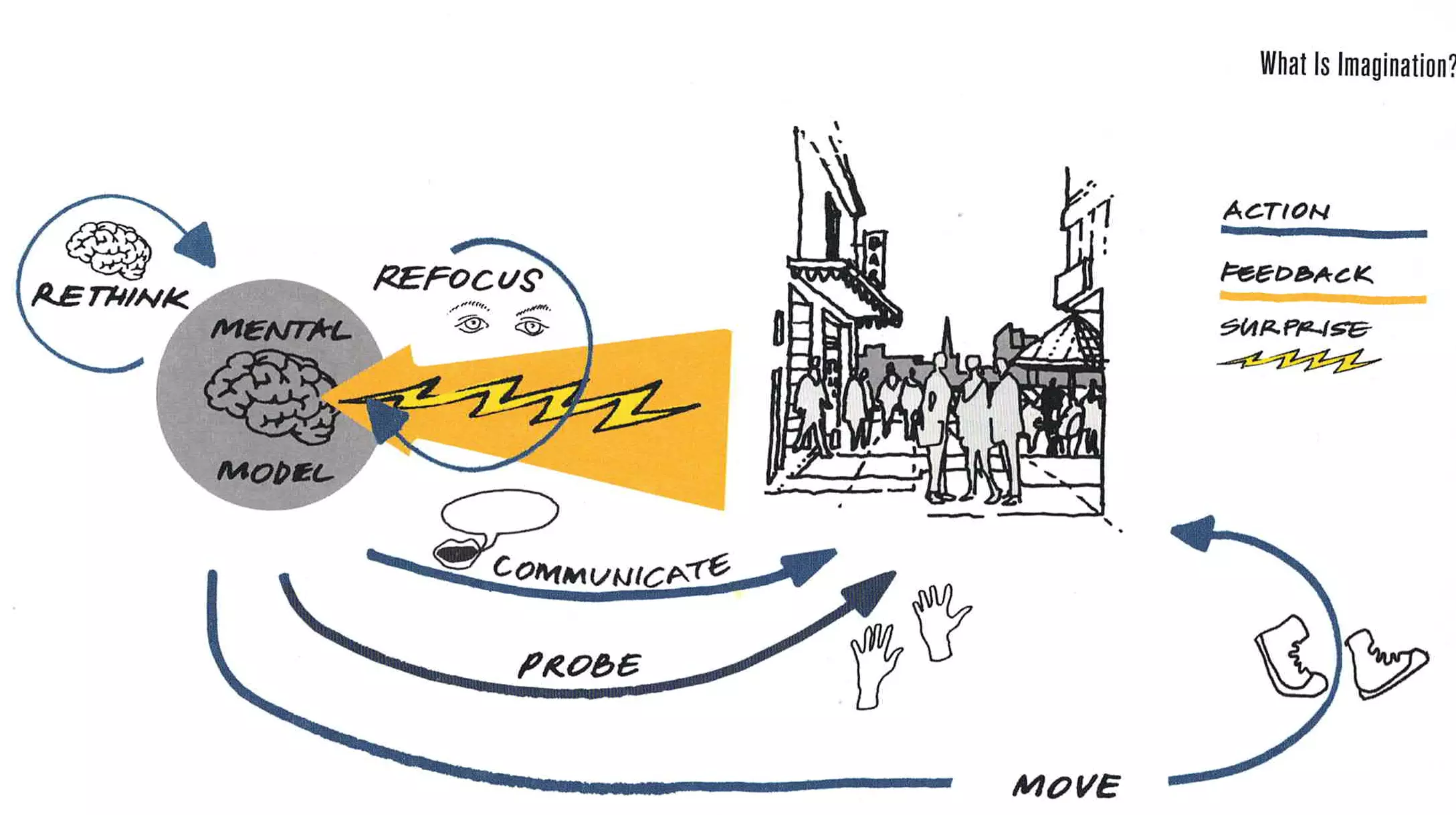
The bulk of the book explains the six phases of systematizing imagination:
- The Seduction – Some surprise seduces our brain to break out of its routine thinking.
- The Idea – Steps to move from a surprise to an idea to a more fully developed mental model.
- The Collision – Colliding an idea with reality to flush out problems, refining the idea to address these, and repeating the collision with reality
- The Epidemic – An idea needs to be adopted by others beyond its creator, so – like a virus – it needs to spread.
- The New Ordinary – A company needs to pivot from initially creating a product or service to consistently delivering it.
- The Encore – How to successfully sustain imagination over time.
The format of these chapters is the same:
- Explaining the concepts and steps in a phase,
- Listing items that could block your progress and providing tips to resolve these,
- Describing games to play with work colleagues to apply concepts in a fun way,
- Sharing "Good Questions to Ask" to prompt deeper thinking, and
- Providing a diagnostic checklist to assess where your company stands in implementing this phase.
The authors provide numerous concrete examples to illustrate their ideas, including:
- A 2006 sketch by Jack Dorsey of the key elements of Twitter,
- Walt Disney's "Profit Formula" approach to generate new sources of revenue, and
- The re-imagining of a wall cleaner into Play-Doh!

Bottom Line – A very useful book that's also fun to explore!
Dear Data: A Friendship in 52 Weeks of Postcards, by Giorgia Lupi and Stefanie Posavec (2016)
A book that's beautiful, amazing, inspiring, and charming!
This book came about by a chance meeting between two women – one living in New York City, and the other in London – who bumped into each other at an arts festival and struck up a long-distance friendship. They had very similar backgrounds – both are visual designers who love drawing, and specifically drawing with data, and both had been collecting and analyzing data since they were young.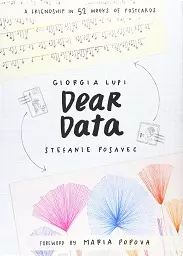
They deepened their friendship by getting to know each other better in a most unusual way. Every Monday for a year, they chose a particular subject to collect data about their lives for the week. Some of their subjects were:
- A Week of Clocks
- A Week of Public Transportation
- A Week of Things We Bought
- A Week of To-Do Lists
- A Week of Interesting Things
At the end of the week, they reviewed and visualized their collected data, drew an illustration of this data on the back of a postcard, added a legend for that illustration on the front of the postcard, addressed and stamped it, and dropped it in the mail!
The book's introduction illustrates their process:
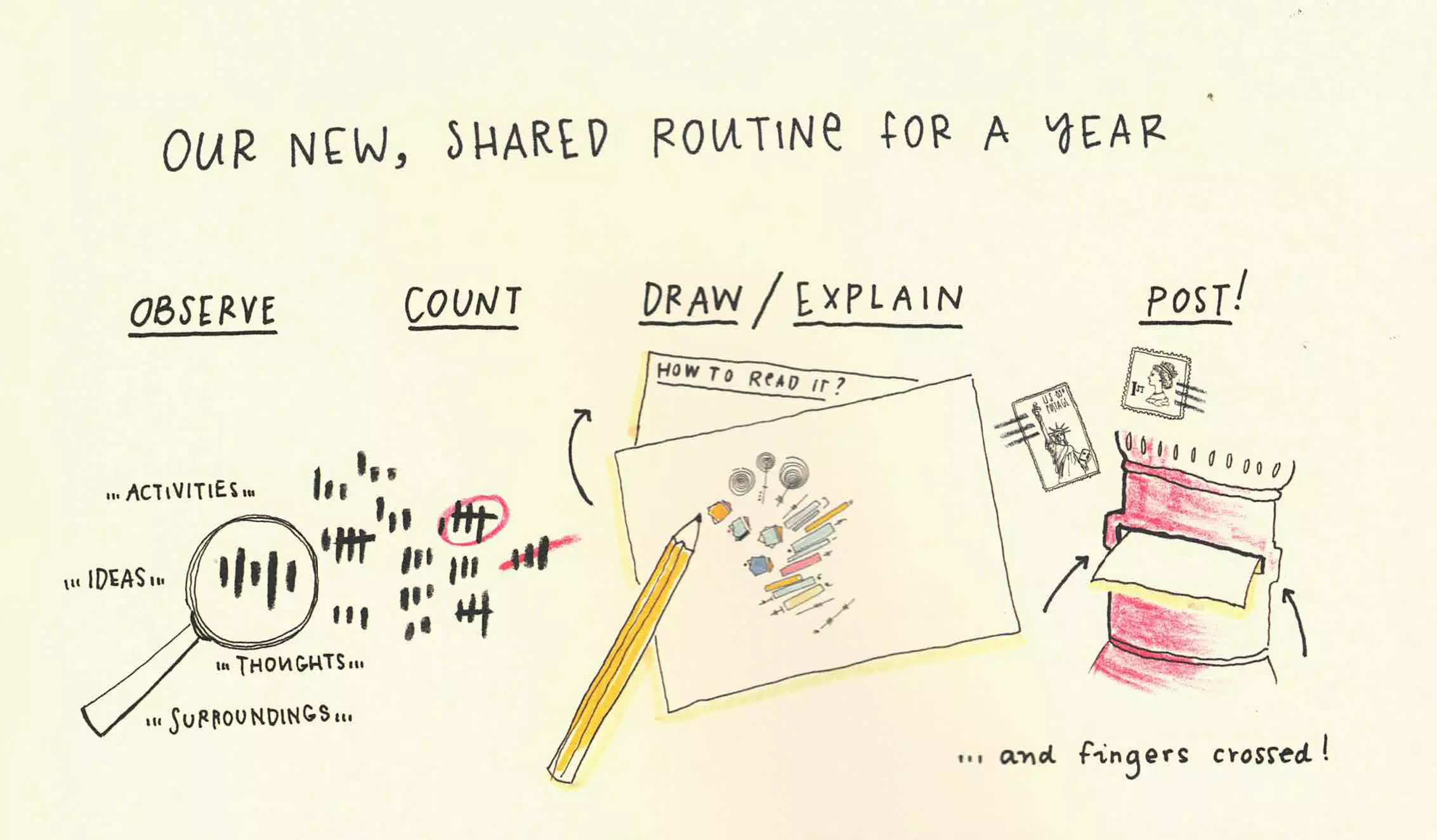
This book compiles those 52 weeks of postcards, visually presenting the data each woman collected on herself for a week to share with her friend. Here's an especially nice set of postcards – "Week Thirty-One – A Week of Positive Thoughts" (pages 164 and 165)
Giorgia's postcard to Stefanie:

Stefanie's postcard to Giorgia:
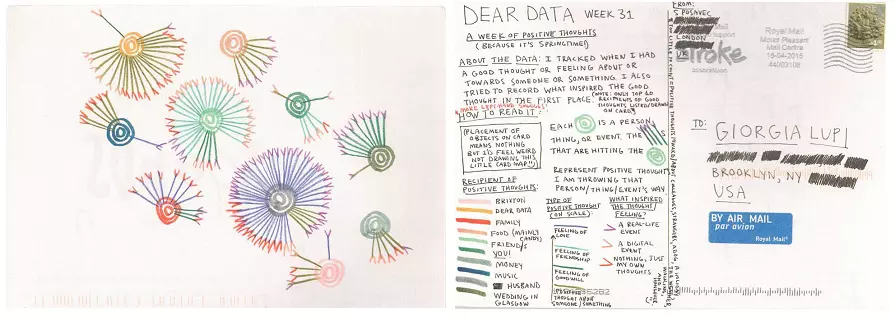
The authors close this fine book with both a good reminder – "To Draw is to REMEMBER." – and an illustrated step-by-step guide on how to create interesting visuals of data.
Bottom Line – This is a beautiful book suitable for your coffee table at home or the lobby in your office! The creativity of these two friends is amazing, and their talent in designing ways to present even the most ordinary data in an engaging manner is inspiring! Finally, the time, effort, and creativity these two friends invested to deepen their friendship is charming! All in all, a very lovely book!
In Closing
While it would be easy to dismiss these books as "not serious" because of how heavily they skew towards visuals, they do cover important business topics – creating a business plan, implementing a process to develop your employees' imagination and consistently bring new products or services to life, and visualizing data in novel ways – in an interesting and engaging manner. Any of these books would be a fine addition to your library.
Sincerely,

Todd L. Herman






